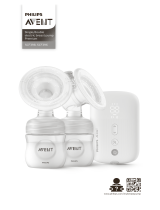
12
expression in your latest
usage.
» You begin to feel the suction
on your breast.
Note
•
The timer starts when the
appliance is power on. The timer
indicator displays 01 after the
appliance has been power on for
1 minute. The unit is minute.
•
The timer will show total breast
pumping time, pause time does
not count in.
•
If the timer displays over 99
minutes (when it comes to 100
minutes), the machine will shut
down automatically.
3 You can choose your desired
stimulation level to stimulate
milk by pressing the level up ( )
and level down ( ) buttons. You
can press the level up button to
deeper the suction. Press the
level down button to lower the
suction.There are altogether 4
stimulation levels. (Fig. 14)
4 Once your milk starts flowing,
you can press the mode
selection button ( ) to switch to
the expression mode. (Fig. 15)
5 After switching to the expression
mode, you can choose your
desired expression level by
pressing the level up ( ) and
level down ( ) buttons. You
can press the level up button to
deeper the suction. Press the
level down button to lower the
suction.There are altogether 4
expression levels. (Fig. 16)
5 Using the electric
breast pump
Before using the pump
•
Wash your hands thoroughly, and
make sure your breasts are clean.
Gently squeeze a little milk from
each nipple to make sure that milk
ducts are not blocked.
•
Make sure you follow the steps
in “Cleaning and sterilising” and
“Assembling” chapters to clean,
sterilise, and assemble the breast
pump.
•
Relax in a comfortable chair,
leaning slightly forward (use
cushions to support your back).
Make sure that you have a glass of
water nearby.
To begin pumping
1 Press the assembled pump
bodies against your breasts.
Make sure that your nipples are
centered, so that the massage
cushion creates an airtight seal.
Make sure that no air escapes;
otherwise there is no suction.
(Fig. 12)
2 Press the power button ( ) to
switch on your pump. (Fig. 13)
» The display panel lights up
for 1 second. The breast
pump automatically starts up
in stimulation level 1 mode
in the first time usage, and
the stimulation indicator
lights up. The appliance
has the memory function
to remember the levels for
your both stimulation and
























